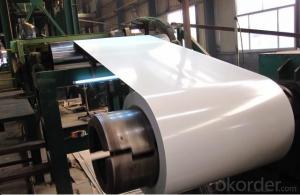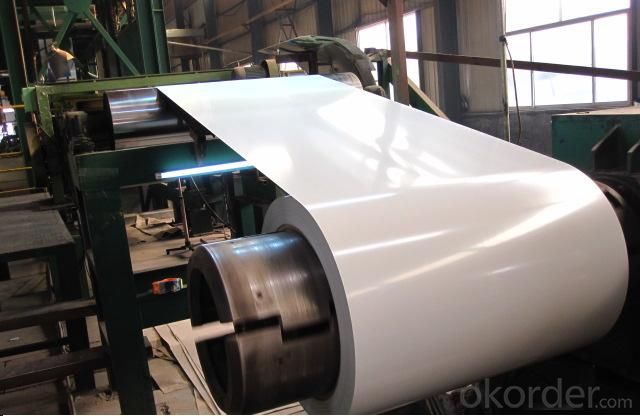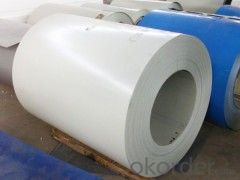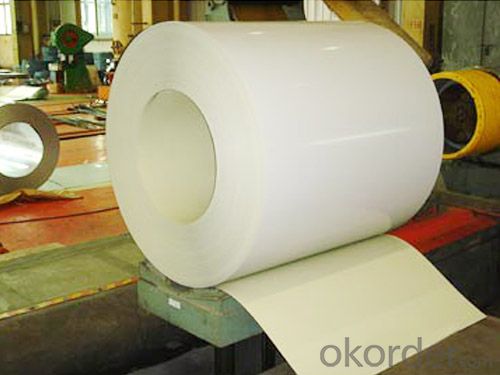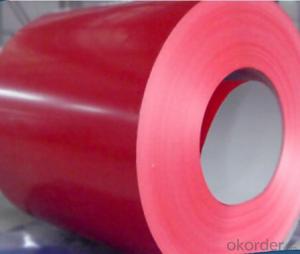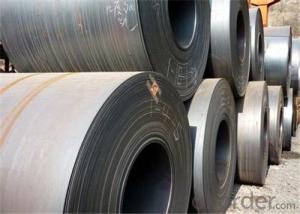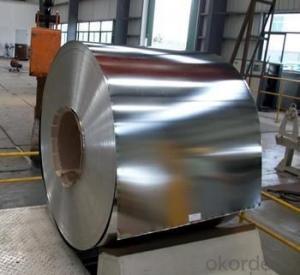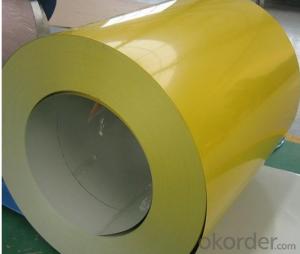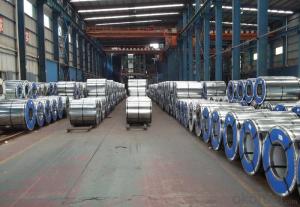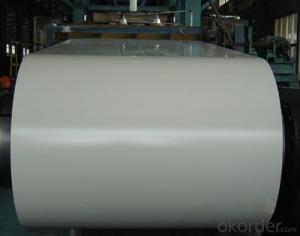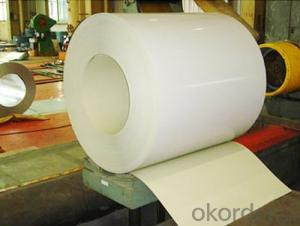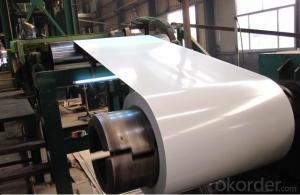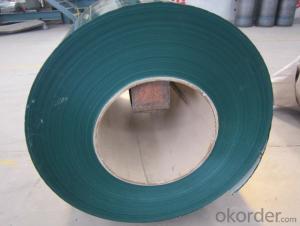PPGI Color Coated Galvanized Steel Coil in Prime White Color
- Loading Port:
- Shanghai
- Payment Terms:
- TT OR LC
- Min Order Qty:
- 200 m.t.
- Supply Capability:
- 10000 m.t./month
OKorder Service Pledge
OKorder Financial Service
You Might Also Like
1. Pre-Painted Galvanized/Aluzinc Steel Coil Description:
With GI as base material, after pretreatment (degrease and chemical treatment ) and liquid dope with several layers of color, then after firing and cooling, finally the plate steel is called pre-painted galvanized (aluzinc) steel. Pre-painted galvanized steel is good capable of decoration, molding, corrosion resistance. It generally displays superior workability, durability and weather resistance.
2.Main Features of the Pre-Painted Galvanized/Aluzinc Steel Coil:
• Excellent process capability
• Smooth and flat surface
• Workability, durability
• Excellent heat resistance performance
• High strength
• Good formability
• Good visual effect
3.Pre-Painted Galvanized/Aluzinc Steel Coil Images
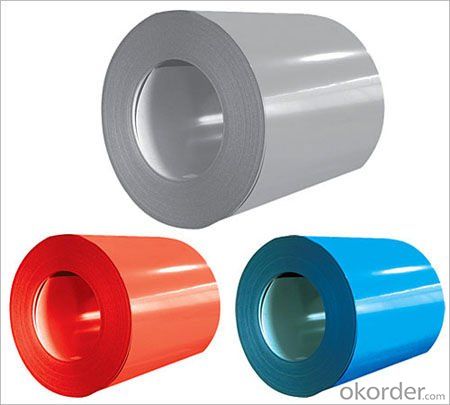
4.Pre-Painted Galvanized/Aluzinc Steel Coil Specification
Standard: AISI, ASTM, BS, DIN, GB, JIS
Grade: DX51D, DX52D
Thickness: 0.17-2.0mm
Brand Name: KMRLON
Model Number: coil
Type: Steel Coil
Technique: Cold Rolled
Surface Treatment: Coated
Application: Boiler Plate
Special Use: High-strength Steel Plate
Width: 20-1250mm
Length: customized
commoidty: pre-painted galvanized steel coil
Thickness: 0.13-4.0mm
width: 20-1250mm
zinc coating: 40-180g/m2
printing thickness: top side: 20+/-5 microns, back side: 5-7 microns
color: all RAL color
surface treatment: color coated
coil weight: 4-7 tons
coil ID: 508/610mm
packaging: standard seaworthy packing
5.FAQ of Pre-Painted Galvanized/Aluzinc Steel Coil
1. What’s the application of this product?
Roof, roof structure, surface sheet of balcony, frame of window, etc.
2. What’s the brand of the paint?
We use the best brand of all of the word—AKZO.
3. How to guarantee the quality of the products?
We have established the international advanced quality management system,every link from raw material to final product we have strict quality test;We resolutely put an end to unqualified products flowing into the market. At the same time, we will provide necessary follow-up service assurance.
4. How long can we receive the product after purchase?
Usually within thirty working days after receiving buyer’s advance payment or LC. We will arrange the factory manufacturing as soon as possible. The cargo readiness usually takes 15-25 days, but the shipment will depend on the vessel situation.
- Q: How are steel coils used in the production of metal fixtures?
- The production of metal fixtures relies heavily on steel coils, an indispensable element. Typically composed of carbon steel, these coils act as the primary raw material for manufacturing a diverse array of metal fixtures. To begin the process, the steel coils are initially uncoiled and subsequently cut into sheets of the desired size and thickness. These sheets serve as the fundamental material for various types of metal fixtures, including brackets, hinges, handles, and other structural components. Once the sheets have been cut, they undergo a series of shaping procedures, such as bending, stamping, or rolling. These procedures are crucial in molding the steel sheets into the specific design required for each metal fixture. For instance, bending can be utilized to create brackets or angles, while stamping can form intricate patterns or shapes. Following the shaping procedures, it is common for the steel sheets to undergo welding or joining techniques, which are employed to assemble multiple components of the metal fixture. Through welding, the various parts are securely attached, ensuring strength and durability in the final product. Moreover, steel coils also play a vital role in enhancing the appearance and extending the lifespan of metal fixtures. They can be coated or treated with protective layers, such as galvanized or powder coatings, to prevent corrosion and provide a polished finish. These coatings guarantee that the metal fixtures can withstand environmental factors and prolong their durability. To summarize, steel coils are an indispensable component in the production process of metal fixtures. They are transformed into sheets, which are then shaped, joined, and coated to create a wide range of functional and aesthetically pleasing metal fixtures utilized across various industries.
- Q: i need this for school and i need to know what are some advantages of stainless steel.
- I would go for stainless steel cookware. There are some advantages of stainless steel cookware that make it so popular. *Durable: stainless steel is tough and can last for years and decades. It is not prone to chipping, rusting or even staining. It won’t dent and scratch easily as well. It is basically indestructible kind of cookware. it can also handle extreme temperatures. *Hard and non-porous. *Appearance: it will remain looking brand new for a long time and this is not because of its high maintenance. *Flavor preservation: stainless steel cookware is made in such a manner that none of the metals in the alloy will be tasted in the food cooked and neither will any of the material come in the food. *Recyclable: in an event where the cookware does get damaged, it can be recycled or salvaged. *Safe: while using stainless steel cookware, you need not be worried about any kind of metal poisoning.
- Q: How are steel coils inspected for surface cleanliness after processing?
- Steel coils are inspected for surface cleanliness after processing through visual examination, using techniques such as optical scanning or high-resolution cameras. Additionally, other methods like acid etching or solvent cleaning may be employed to remove any contaminants or residues on the surface to ensure the coils meet the required cleanliness standards.
- Q: Describe and explain how the differences in the properties of the thee main types of steel allow them to be used in different ways. I have some chemistry homework due in for tomorrow (yes I know i left it a bit late but I really don't like chemistry) and I would love it if I could actually at least pretend to my teacher that I know what she's on about this lesson because honestly, I really don't know what she spends so long telling us all. Any help would be appreciated and points for the best answer!
- TYPES OF STEEL: CARBON STEEL ============= Steels containing 0.2% C to 1.5% C are known as carbon steel. They are of three types. Low Carbon Steel It contains 0.2% carbon. Uses: Sheets, wires, pipes. Mild Carbon Steel It contains 0.3% to 0.7% carbon. Uses: Rails, boilers, plates, axles, structures. High Carbon Steel It contains 0.7% to 1.5% carbon. Uses: Surgical instruments, razor blades, cutlery, spring. STAINLESS STEEL =============== It contains 14% to 18% chromium and 7% to 9% nickel. Uses: Car accessories, watch case, utensils, cutlery. ALLOY STEEL ============= There are three types of alloy steel. Mn-Steel It contains 10%-18% Mn. Uses: Rail tracks, armor plate, safe. Si-Steel It contains 1% to 5% Si. Uses: Permanent magnet. Ni-Steel It contains 2% to 4% Ni. Uses: Machine components, Gear, shaft, cable. :) Ref. www.google .in/search?q=wikiso...
- Q: I wanna strip down my bike and take off all the paint... im thinking of leaving it just the steal color... Do i need to put anythinng on the steel to coat it or can i just leave it like that... Will it rust or anything?
- It depends on the steel, assuming your bike isn't aluminum. Since your bike isn't likely made of stainless steel or weathering steel, it really ought to be protected from the elements. You can do this in different ways. I've seen bare metal last many years in the weather with a regular dousing of oil. I've even seen a guy just pour his used motor oil over his battered old truck. Now don't be misled - the truck looked like hot buttered hell, but the steel was all good on a fifty year old truck. Those are real world results and if you don't mind the oil staining the inner thighs of your pants so it looks like you had an accident on the way to wherever, it's an option. Or you can paint it back, only in clear coat.
- Q: Are steel coils used in furniture manufacturing?
- Yes, steel coils are commonly used in furniture manufacturing. They are often used as a supportive framework in upholstered furniture, such as sofas and chairs, providing stability and durability to the overall structure.
- Q: I remember my dad saying something about steel toed boots but I forgot =#92; I went and checked out all the stores and got a pair with good ankle support but they also have steel toes. Would this interfere with the shifter or anything? I figure if anything my dirt bike shoes have the steel toes too. Any opinion?
- I personally like to feel the shifter, and I've found that I can't feel the shifter as well through steel toed boots. Steel toed boots are designed to protect you in the event of something heavy dropping on your foot - which isn't very likely on a motorcycle. I have also found that in extreme cold that steel toed boots seem to act like a heat sink for your feet - non steel toed boots seem to stay just a little bit warmer. If you're a new rider, a very blunt toe (whether steel or not) can make getting your toes under the shifter a little more difficult, but with some practice and experience, you will get used to it. Honestly, I don't think it really makes all that much difference. All new riders have difficulty with the shifter, and it will take time for you to get used to it either way. I don't think the difference is really even worth going out and buying another set of boots, but yeah, if you were getting your first pair, I would tell you to look for a boot with a toe that is slender and tapered (vs. blunt), and non-steel.
- Q: I work at a tool store. I told my boss last week we needed more pruning shears so he did get more of all kinds. Thing is out of all of the shears he brought Two of different kinds say they are made out of Japanese steel. I have never heard of Japanese steel so now i ask you (the public) whats the difference between it and steel from the US or any other country? Those shears are worth more then the ones he gets from Mexico and China and even more than Black and Decker, Fiskars, etc but not more then Corona brand ones.
- Well Japan, with democracy and code standards, would be better than China or Mexico, with poorly paid workers and poor standards and poor quality. I don't know why or if its better quality than US steel
- Q: What are the different grades of steel used for manufacturing coils?
- Manufacturing coils requires the use of various grades of steel, each selected for their specific properties and suitability for different purposes. Some commonly used grades include low carbon steel, high carbon steel, stainless steel, galvanized steel, and alloy steel. Low carbon steel, also known as mild steel, is a cost-effective option with good formability. It is ideal for applications that require low strength and high ductility, such as automotive components and construction materials. High carbon steel is characterized by its exceptional strength and hardness. It is commonly employed in the production of coils that demand high tensile strength, like springs and wires. Stainless steel, an alloy with a high chromium content, offers corrosion and oxidation resistance. It is often utilized in the manufacturing of coils for the food industry, medical equipment, and automotive applications. Galvanized steel, on the other hand, is steel coated with a layer of zinc to safeguard it against corrosion. It is frequently used in the production of coils that will be exposed to harsh environmental conditions or require excellent durability, such as roofing materials and electrical appliances. Alloy steel, formed by adding elements like manganese, nickel, chromium, or molybdenum to carbon steel, exhibits improved strength, hardness, and resistance to wear and corrosion. It finds wide application in industries that necessitate high strength and toughness, such as aerospace and automotive. Choosing the appropriate grade of steel is crucial to ensure optimal performance and longevity of the coils, as it is essential to match the specific requirements of the application.
- Q: What are the common methods of transporting steel coils?
- There are several common methods of transporting steel coils, depending on the distance, quantity, and specific requirements of the shipment. The most commonly used methods include: 1. Flatbed trucks: This is the most basic and widely used method for short-distance transportation of steel coils. Flatbed trucks have a flat, open trailer bed that allows for easy loading and unloading of the coils. The coils are secured and strapped down to prevent movement during transit. 2. Rail transport: For longer distances, rail transport is often preferred due to its cost-effectiveness and efficiency. Coils are loaded onto specially designed railcars, known as coil cars or gondola cars, which have curved troughs or cradles to hold the coils securely in place. This method is particularly advantageous for large quantities of steel coils. 3. Ocean freight: When transporting steel coils internationally or over long distances across oceans, shipping by sea is a common method. The coils are typically loaded into specialized shipping containers, known as coil containers or coiled steel containers, which have internal cradles to prevent movement and damage during transit. These containers are then loaded onto cargo ships for transportation. 4. Barge transport: In regions with navigable waterways, barges can be used to transport steel coils. Similar to ocean freight, the coils are loaded into specially designed containers or barges with cradles to secure them during transport. Barges offer an economical and environmentally friendly option, especially for inland waterway transportation. 5. Intermodal transport: In some cases, a combination of different modes of transportation may be used for transporting steel coils. This is referred to as intermodal transport. For example, steel coils may be initially transported by truck to a rail yard, where they are then loaded onto railcars for long-distance transport. This method allows for the advantages of different modes of transportation to be combined, optimizing cost and efficiency. It is worth noting that the specific method of transporting steel coils may vary depending on factors such as coil size, weight, destination, and any specific handling requirements.
Send your message to us
PPGI Color Coated Galvanized Steel Coil in Prime White Color
- Loading Port:
- Shanghai
- Payment Terms:
- TT OR LC
- Min Order Qty:
- 200 m.t.
- Supply Capability:
- 10000 m.t./month
OKorder Service Pledge
OKorder Financial Service
Similar products
Hot products
Hot Searches
Related keywords
